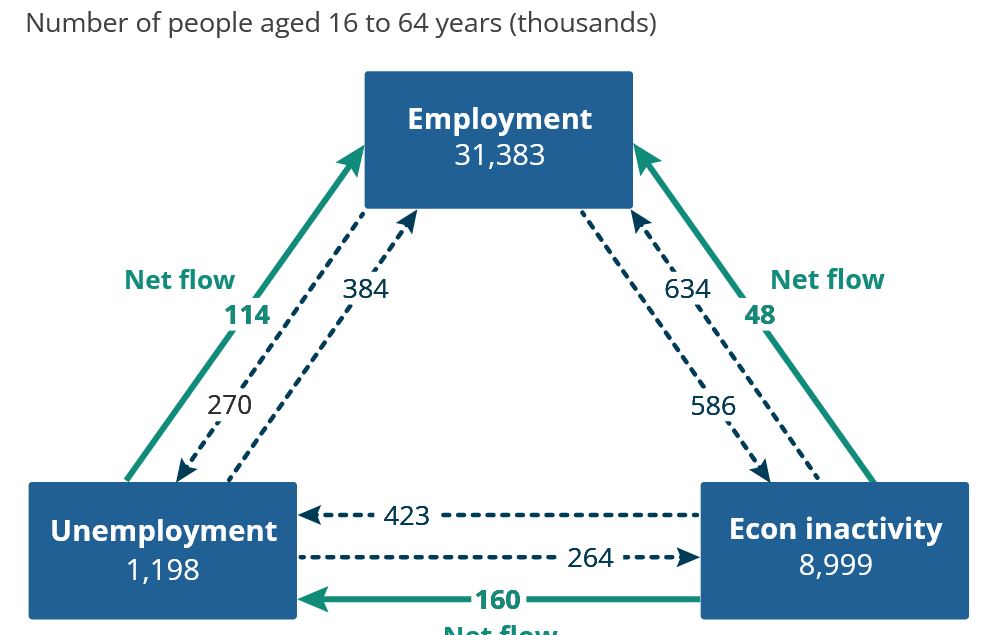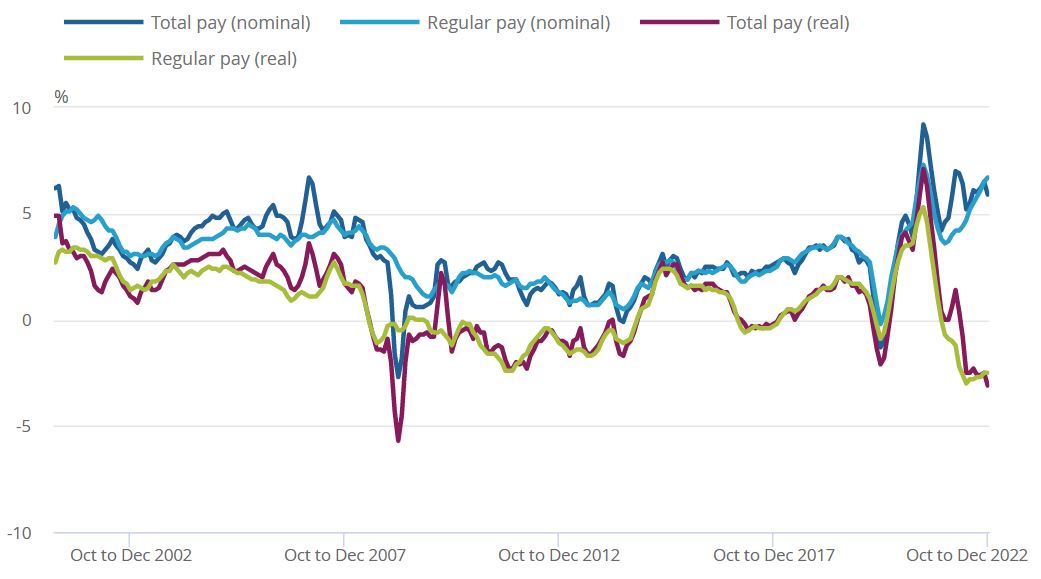ONS Labour Market February 2023
Seventh consecutive quarterly fall in vacancies
- The number of job vacancies in November 2022 to January 2023 was 1,134,000 – a decrease of 76,000 from August to October, marking the largest quarterly fall since May to July 2020.
- The largest falls came administration and support service activities (down by 9,000 on the quarter), followed by manufacturing, and education (both down by 8,000).
- The two industries to show growth on the quarter were mining and quarrying, and financial and insurance activities, but their combined growth only provided 1,000 more vacancies.
- The total number of vacancies was 338,000 above the January to March 2020 pre-pandemic level.
Fall in retail employees
- Early payroll estimates for January show the number of payrolled employees rose by 768,000 employees compared to the previous year (up 2.6%).
- On the previous month, the number of payrolled employees rose by 102,000, or 0.3%.
- The largest yearly increase in payrolled employees continued to be driven by health and social work sector (a rise of 143,000 employees YoY), while the smallest was in the wholesale and retail sector (a fall of 11,000).
Record flow out of inactivity
- The unemployment rate for October to December increased by 0.1pp on the quarter to 3.7%.
- In the quarter, the number of people unemployed for up to a year increased, partly driven by those aged 16 to 24 years, while those unemployed for over 12 months decreased.
- The economic inactivity rate decreased by 0.3pp on the quarter to 21.4% in October to December, declining largely among 16 to 24 year olds. Although declining, inactivity is 1.2pp above the pre-pandemic level.
- Flows estimates show that there was a record-high net flow out of economic inactivity between July to September and October to December. This was driven by people moving from economic inactivity to employment, with 62% of the inflows to employment coming from economic inactivity.
UK flows between employment, unemployment, and economic inactivity, people aged 16 to 64 years, seasonally adjusted, July to September 2022 and October to December 2022

Source: Office for National Statistics
Employment rate edges up
- The employment rate for October to December rose 0.2pp in the quarter to 75.6%, but is 0.9pp below pre-pandemic levels.
- The number of part-time employees saw the largest increase since September to November 2021 over the latest three-month period, while full-time employees decreased.
Hours worked declines
- Total actual weekly hours worked decreased by 2.9 million hours compared with the previous quarter to 1.04 billion hours in October to December.
- This is 16.6 million below pre-pandemic levels (December 2019 to February 2020), largely as a result of fewer people in employment, with average weekly hours worked at pre-pandemic levels.
- Total hours worked have been impacted by additional bank holidays in the summer and autumn, as well as strikes in recent periods.
- The decrease in the latest three-month period was driven by men, whose actual weekly hours worked remain below pre-coronavirus levels. The total actual weekly hours worked by women increased and remain above pre-coronavirus levels.
Real earnings decline
Both annual total and regular pay growth continued to lag inflation in the three months to December.
- In nominal terms, average regular pay (excluding bonuses) for employees in Great Britain was £588 per week before tax and other deductions from pay in December – up from £552 per week a year earlier.
- Average total pay (including bonuses) for employees in Great Britain was £630 per week before tax and other deductions from pay in December – up from £603 per week a year earlier.
- Regular pay rose by 6.7% and total pay by 5.9% in the three months to December compared to a year earlier. For regular pay, this remains the strongest growth rate seen outside of the pandemic period.
- Average regular pay growth in the private sector rose at its strongest rate outside of the pandemic at 7.3% in the three months to December, while the public sector rose by 4.2%.
- In real terms (adjusted for inflation), regular pay and total pay declined 2.5% and 3.1% YoY respectively in the three months to December. This remains among the largest falls in growth since comparable records began in 2001.
Average weekly earnings annual growth rates in Great Britain, seasonally adjusted, January to March 2001 to October to December 2022

Source: ONS
Back to Retail Economic News